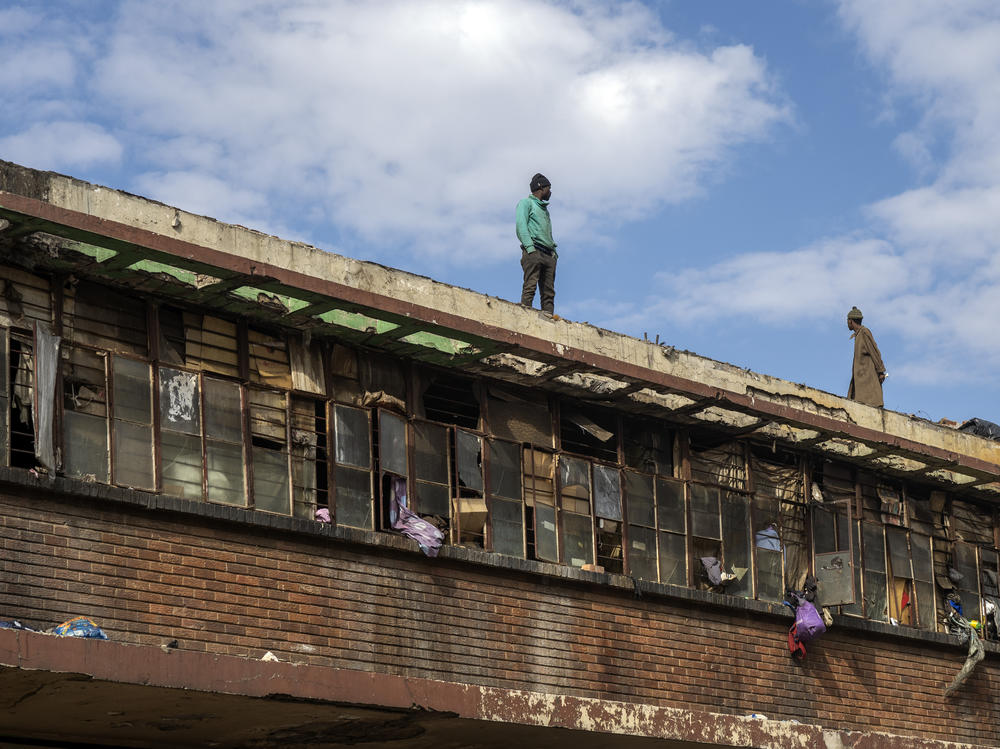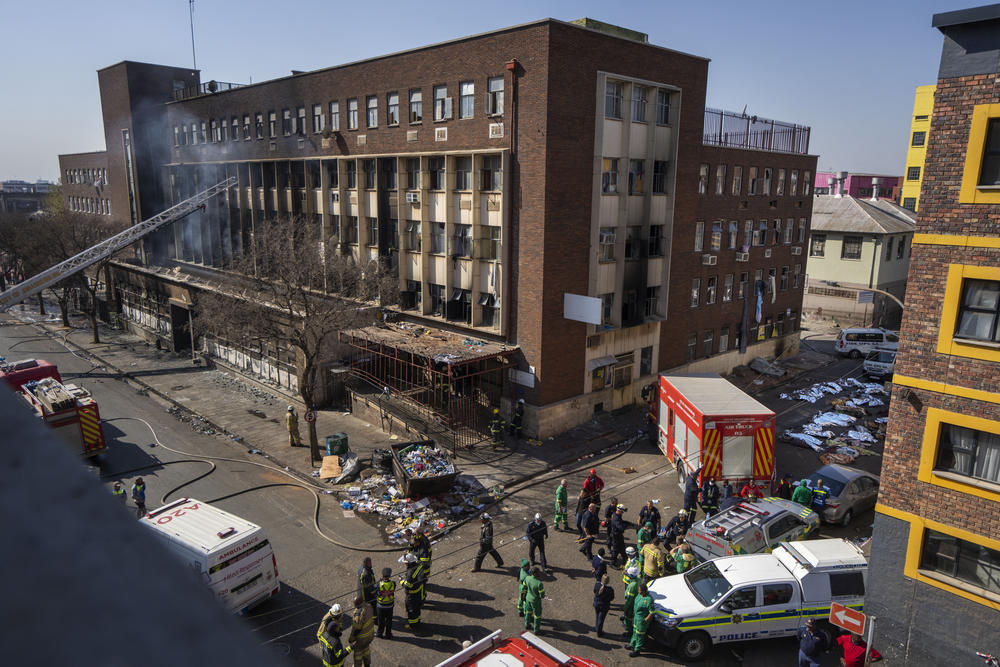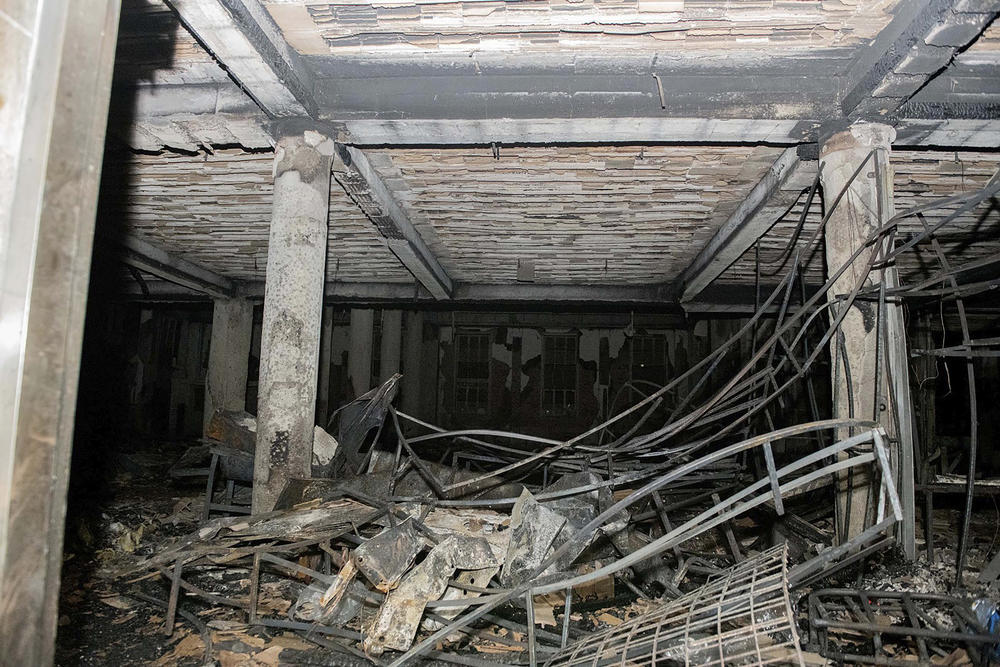Section Branding
Header Content
With Johannesburg's building fire, the misery of gang-hijacked towers comes into focus
Primary Content
JOHANNESBURG — This is a tale of two cities. One is Africa's richest metropolis: glitzy shopping malls, gated estates, swanky restaurants and leafy streets. The other — where 76 people died in an inferno that engulfed a derelict building on Thursday — has garbage rotting in the gutters, jobless men drinking morning beers and an abundance of ads for abortion clinics and funeral parlors.
The building that caught on fire is in what's still called the Central Business District, even though big corporations have long moved out to the safer suburbs, leaving behind abandoned office spaces that, in South African parlance, have now become "hijacked."
That means people desperate for housing in a country where unemployment is among the highest in the world — officially at 33% but likely much higher — have taken to squatting in squalid conditions in the multi-story buildings, forced to pay rent to the criminal gangs that now run them.
This is nothing new in this city of 6 million but made headlines this week after the worst fire in recent memory prompted renewed calls for action and led to much political finger-pointing. Authorities are still investigating what exactly caused the disaster.
Jumping from windows
Survivors of the fire, which broke out early Thursday morning, described how they were unable to get out of the five-story building's exit because security gates were locked. Some jumped from windows and one mother threw her baby wrapped in a blanket out of a second-floor window to safety.
After fire-fighters extinguished the blaze, forensics teams collected remains, with white body bags laid out in the street in neat rows. Desperate family members searched for loved ones, while survivors huddled with the sparse belongings they'd rescued — blankets, a boombox.
Prudence Ndlovu, 29, stood in a crowd behind a police cordon, staring at the charred and gutted building that was her only home.
Paying rent to cartels
A Zimbabwean, Ndlovu is, like many of the fire's victims, a migrant from a poorer African country who came to Johannesburg — often dubbed "The City of Gold" — looking for a better life but encountering crime and xenophobia.
She said she paid the cartel who had hijacked the building 1,200 South African rands a month in rent, about $60. For that she lived in a makeshift shack erected within the building with her two children and boyfriend.
Inside, the haphazardly partitioned buildings have broken windows, dark stairwells, piles of garbage and sewage, and people's few belongings — a dirty mattress, a cooking pot.
For some privacy many living in buildings like this use bits of wood, curtains and cardboard to divide their space — all highly flammable materials, especially when many residents cook on fires in large metal drums or use candles when the illegal electricity connection attached to the squat fails.
While the exact cause of the fire isn't known, residents and some officials have suggested that candles could have been what sparked it. South Africa is in the midst of a power crisis and there was a blackout at the time, residents said.
Ndlovu, who ekes out a living selling snacks on the street, told NPR she had "lost everything" in the fire. She said herself and her children had only survived because they'd spent the night of the fire staying at her sister's house.
"When I see today happening this thing, I think God was the one moving me there," she said. "I see ... the other lady lose the child and the other child is in hospital."
At least 12 children died in the fire.
Authorities don't enter
Meanwhile, Mthabiseng Maimane, from a neighboring apartment block, complains criminal elements in such hijacked buildings are contributing to Johannesburg's already shockingly high crime rates.
"What is happening here, the things that we see every day, we're not even safe. ... How do the people take over the buildings?"
"Even for my kids, I fear for my kids ... they can't even go outside to play," she said, adding that there are drug gangs and crystal meth addicts in the abandoned tower blocks.
The security is so precarious that even the police are scared to enter the city's hijacked buildings — of which there are believed to be dozens.
Lebogang Isaac Maile, the head of the provincial Department of Human Settlements, said the fire "demonstrates a chronic problem of housing in our province as we've previously said that there's at least 1.2 million people who need housing."
"There are cartels who prey on who are vulnerable people. Because some of these buildings, if not most of them, are actually in the hands of those cartels who collect rental from the people," he told media.
The building at 80 Albert St. that burned this week — and which officials say may have housed as many as 200 families — has a past that's testament to South Africa's notorious history of racial discrimination.
It started out during the apartheid era as a building used by the white minority government to enforce its racist laws. It was an office for Black people to obtain their "passes" — documents that controlled their movement in the segregated city.
After the dawn of South Africa's democracy in 1994, the building became a shelter for abused women and children. When that moved out, the building — which is still owned by the city — became "hijacked." The building last had a safety inspection in 2019, the year gangs took it over, according to Rapulane Monageng, acting chief of Johannesburg emergency medical services.
"We wouldn't want to go back in there in a hostile environment," Monageng told local media about why after that it was left alone.
Some officials blame the country's strong anti-eviction laws for making it too hard to remove people once they've occupied a building. Though nongovernmental organizations say these are essential to protecting the dispossessed. And there's also the question of where to move them to.
President Cyril Ramaphosa visited the site in the aftermath of the tragedy, saying it was a "wake-up call" regarding the city's affordable housing crisis.
However, opposition groups say the government has known about and neglected the problem for years. They say billions of rands have been lost to corruption over the years that could instead have been used to build housing for the poor.
But that's cold comfort for those now displaced by Thursday's fire, and for the many South Africans and foreign migrants living precarious existences in Johannesburg's remaining hijacked buildings — any one of which could be another disaster waiting to happen.
Copyright 2023 NPR. To see more, visit https://www.npr.org.



